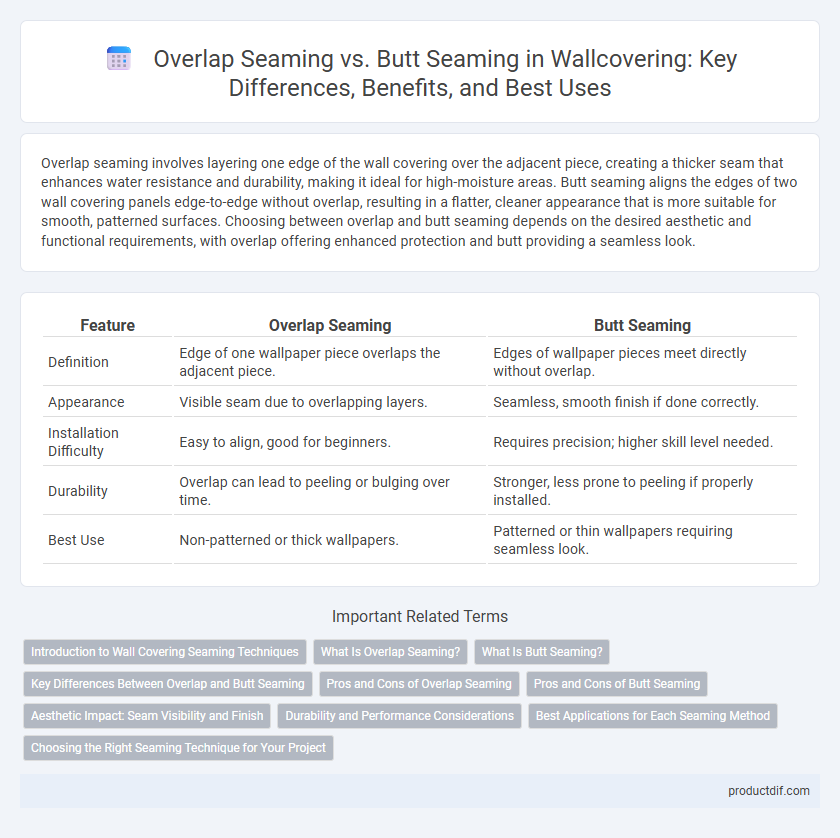Overlap seaming involves layering one edge of the wall covering over the adjacent piece, creating a thicker seam that enhances water resistance and durability, making it ideal for high-moisture areas. Butt seaming aligns the edges of two wall covering panels edge-to-edge without overlap, resulting in a flatter, cleaner appearance that is more suitable for smooth, patterned surfaces. Choosing between overlap and butt seaming depends on the desired aesthetic and functional requirements, with overlap offering enhanced protection and butt providing a seamless look.
Table of Comparison
| Feature | Overlap Seaming | Butt Seaming |
|---|---|---|
| Definition | Edge of one wallpaper piece overlaps the adjacent piece. | Edges of wallpaper pieces meet directly without overlap. |
| Appearance | Visible seam due to overlapping layers. | Seamless, smooth finish if done correctly. |
| Installation Difficulty | Easy to align, good for beginners. | Requires precision; higher skill level needed. |
| Durability | Overlap can lead to peeling or bulging over time. | Stronger, less prone to peeling if properly installed. |
| Best Use | Non-patterned or thick wallpapers. | Patterned or thin wallpapers requiring seamless look. |
Introduction to Wall Covering Seaming Techniques
Overlap seaming involves layering one wallpaper edge over the adjacent strip to provide extra protection against moisture and ensure a continuous pattern alignment, making it ideal for high-humidity areas. Butt seaming, where edges meet precisely without overlapping, offers a clean, flat finish and is commonly used with non-textured or vinyl wallpapers to minimize visible seams. Understanding the differences in durability, appearance, and installation ease between overlap and butt seaming is crucial for selecting the appropriate wall covering technique.
What Is Overlap Seaming?
Overlap seaming is a wall covering technique where two wallpaper edges are overlapped to create a secure seam, ensuring greater moisture resistance and durability in high-humidity areas. This method reduces visible gaps and strengthens the joint, making it ideal for textured or vinyl wallpapers. Overlap seaming contrasts with butt seaming, which aligns edges without overlap, often requiring precise matching to prevent peeling and seam visibility.
What Is Butt Seaming?
Butt seaming in wall covering involves aligning two wallpaper edges edge-to-edge without overlapping, creating a seamless, flat surface. This technique requires precise cutting and careful application to avoid gaps or visible seams, ideal for patterns that must match perfectly. Butt seaming contrasts with overlap seaming, where one edge overlaps the other, often resulting in a more textured finish.
Key Differences Between Overlap and Butt Seaming
Overlap seaming involves placing one wall covering strip over the adjacent strip, creating a layered joint that enhances durability and prevents moisture infiltration. Butt seaming aligns the edges of two strips directly next to each other, resulting in a flat, seamless appearance suitable for smooth surfaces. The key differences lie in moisture resistance, aesthetic finish, and application complexity, with overlap offering better protection and butt providing a cleaner look.
Pros and Cons of Overlap Seaming
Overlap seaming in wall covering offers superior moisture resistance by effectively sealing joins, reducing the likelihood of mold and mildew growth. This method provides easier alignment during installation, allowing for minor adjustments and better coverage of wall imperfections. However, overlap seaming can create slight ridges at the seams, potentially affecting the smoothness and aesthetics compared to butt seaming.
Pros and Cons of Butt Seaming
Butt seaming in wall covering creates a seamless appearance by aligning edges without overlap, making it ideal for patterns that require precise matching. It reduces material waste and ensures a smooth, flat finish but can be less durable as the seams may peel or become more visible over time. Proper surface preparation and high-quality adhesives are essential to strengthen butt seams and prevent potential peeling issues.
Aesthetic Impact: Seam Visibility and Finish
Overlap seaming creates a more textured and dimensional look by layering wallpaper edges, which can enhance pattern continuity but may result in slightly visible seams. Butt seaming offers a smoother, flush finish by aligning edges precisely, minimizing seam visibility and delivering a cleaner, modern aesthetic. The choice between the two depends on the desired visual effect and the intricacy of the wallpaper pattern.
Durability and Performance Considerations
Overlap seaming enhances wall covering durability by providing a more secure seal against moisture and dust infiltration, reducing the risk of peeling or lifting over time. Butt seaming offers a cleaner, more precise finish but may require stronger adhesives and meticulous installation to maintain long-term performance under stress conditions. Choosing between these methods depends on the specific wall covering material and environmental factors impacting durability and maintenance.
Best Applications for Each Seaming Method
Overlap seaming is best suited for textured or heavy-duty wall coverings such as vinyl or fabric-backed wallpapers because it provides enhanced durability and helps prevent moisture penetration. Butt seaming is ideal for smooth, lightweight wall coverings like traditional paper or non-woven wallpapers, ensuring a seamless appearance with minimal overlap visibility. Choosing the correct seaming method depends on the wall covering material and the desired finish, improving both aesthetic appeal and longevity.
Choosing the Right Seaming Technique for Your Project
Choosing the right seaming technique for wall coverings depends on the material and desired finish. Overlap seaming provides extra durability and moisture resistance by layering edges, making it ideal for vinyl or heavier wall coverings in high-traffic or humid areas. Butt seaming creates a cleaner, smoother appearance suitable for thinner or non-woven wallpapers where a nearly invisible seam is preferred.
Overlap Seaming vs Butt Seaming Infographic

 productdif.com
productdif.com